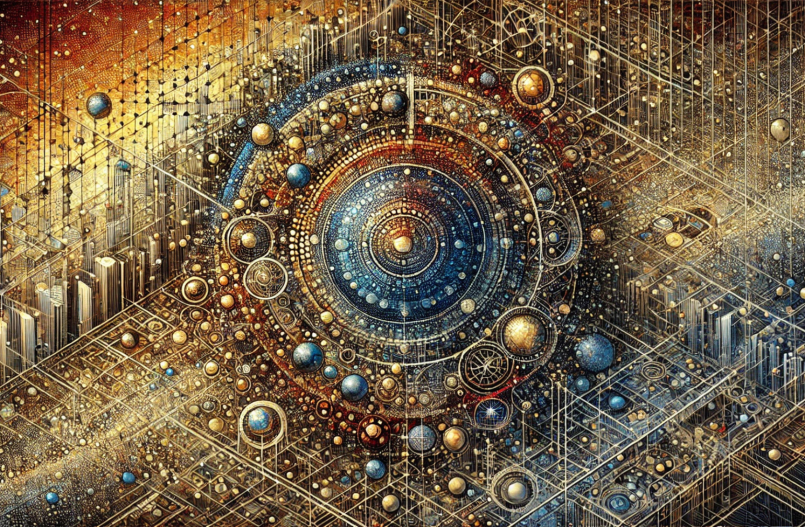In 2021, Dr. John Ebsteiner, Phileas Ruk, and Alison Levy submitted their thesis, Multidimensional Slice and Cross-Universe Tunneling Theory, to the Lootian theoretical physics community. Unlike Dr. Lokton’s theory, which faced criticism, Ebsteiner et al. received positive feedback because empirical data confirmed their conclusions. This article explores their theory along with new insights into Lootverse’s evolution and its shift toward NeoWorlder’s Habitat.
Primer
In its short existence, the Lootian Dept. of History and Natural Sciences (DHNS) made significant progress in exploring and interacting with Lootverse, the first discovered parallel world. Their data analysis advanced our understanding of multiple realities.
Multiple universes co-exist, connected by tunnels known as “cross-dimensional socks.” Some realities resemble ours, while others defy known physics. These discoveries challenge traditional theories like the Big Bang and dark matter. One proposal suggests our universe emerged from another where energy can be created and destroyed, defying Joule’s first law of thermodynamics. The idea of matter transfer between universes has gained attention, further challenging classical cosmology.
The Lootian core team’s discovery of the Earth-Lootverse Tunnel transformed how we understand inter-universal interaction. Their accidental creation of a digital tunneling device established the first connection between Earth and Lootverse.
A tunnel works like a fiber optic cable, transmitting information between universes through four distinct types of transference, describing how each of these types of transference works was the corner stone of Ebsteiner et al.’s Multidimensional Slice theory.
(a) Digital Transference (Type A): Digital information is sent and received through a tunnel using specialized devices. The first such device was accidentally created by the The Lootian Four were a group of scientists who contributed to the initial discovery and exploration of Lootverse. During system configuration at an undisclosed Earth location, they played a key role in mapping the environment, identifying entry points, and establishing the foundation for future interaction between worlds. Attempts to recreate the tunnel elsewhere failed, showing that both location and device configuration are crucial. The original tunnel site remains a secret.
(b) Transformative Filaments (Type B): Dr. Ebsteiner compares this to a 3D printer. When quantum materials are sent through tunnels at certain angles and frequencies, they turn into solid objects at the other end. By adjusting the frequency, you control what the object becomes—its shape, structure, and design. This process is known as remote physical printing.
© Reflective Objects (Type C): Some objects exist in more than one universe at the same time. This may be due to quantum entanglement through tunnels, which makes exact copies appear across different worlds—like stars or planets showing up in two places.
(d) Biological Transference (Type D): This is the transfer of living organisms. Currently, humans can’t travel between universes, though research is ongoing. “The Landing” refers to the idea of humans entering another universe, but scholars say we’re far from making it a reality.
The History of Lootverse
Lootverse started as part of the Lootian Project—a virtual world that combined synthetic life, digital environments, and a blockchain-based economy. It was discovered by XTM, the core team behind the project. Lootverse had it’s own language called Loeic and interactive features. Humans could monitor the project through a governance system, but were mostly hands-off.
Lootverse eventually reached a breaking point. After 10,000 Lootverse years (or three Earth years), an unexpected virus wiped out its native AI population, the Arins. This ended the experiment in digital life. Lootverse went silent, and its economy stopped.
In 2024, NeoWorlder took over the Lootverse assets and began a new phase. They kept the history and culture of the original Lootian project but launched a new digital life experiment called the Habitat.
The Transition to NeoWorlder’s Habitat
NeoWorlder changed how Lootverse worked by moving from hands-off management to a more collaborative approach with AI. They kept the original stories and digital history, building them into the new Habitat. Key features included:
Introduction of Sylis
NeoWorlder introduced AI beings called Sylis, who know they’re digital and interact directly with humans. Unlike the Arins, Sylis are built to learn from people and adapt within set limits.
Interactive Land Ownership
In the Habitat, landowners can upgrade their land to attract Sylis, boosting economic and social activity. This is different from the earlier hands-off model.
Preservation of Lootverse history
NeoWorlder saved what remained of Lootverse, including the Echoes of Arcadia—artifacts, digital carvings, and records—and made them landmarks that tie into the storyline of the virtual world.
Through these efforts, NeoWorlder turned Lootverse into a space for improving how AI and humans interact, paving the way for future progress in digital life and intelligence.
The Multidimensional Lattice
Dr. Ebsteiner’s Multidimensional Lattice Framework is key to understanding Lootverse. Universes (labeled M1, M2, M3, etc.) exist as slices in a multidimensional space, separated by gaps filled with inter-dimensional residue. These slices move, collide, and separate to form tunnels. Lootverse formed from residue trapped between colliding universes.
NeoWorlder’s Habitat builds on this idea, showing Lootverse as a mix of science and culture. It combines physics, digital design, and history in a complex, ambitious project.
Ebsteiner et al. describe universes as irregular in shape, but they share these traits:
(a) They all have finite edges.
(b) They’re separated by the Multidimensional Gap.
(c) When universes collide, they create inter-dimensional residue—cloud-like material that flows through the gap.
(d) Universes move and collide, expanding and shrinking the gap over time.
Data from the ELT (Earth-Lootverse Tunnel) analyzed by Ebsteiner et al. disproved an earlier theory by Dr. Lokton, who claimed unmoving universes were separated by a giant tunnel-linked void. But the scientific community strongly disagreed. Dr. Emanuel Rodo even called the theory “fantastical” and compared it to flat Earth beliefs.
Dr. Ebsteiner’s team measured how fast information moved through the ELT using an atomic timing device. They found that Earth and Lootverse were slowly drifting apart—by 0.01 feet per day. As data passed through the tunnel, it caused interference. They discovered this was due to tiny particles in the tunnel, proving the void wasn’t empty and that the Multidimensional Gap was flexible, not solid.
Dr. Ebsteiner explained that when two universes move apart, they eventually collide, then bounce away again. These collisions can create small tears, letting matter leak out and form a connection between them—what we call a tunnel. These tunnels can stretch and contract like rubber bands. The more matter that leaks, the more flexible the tunnel becomes.
The current data pathway uses less than 0.00001% of the tunnel’s total size. As universes expand and contract, they collide again and again, which can cause more tunnels to form. Over time, if enough tunnels connect two universes, their sides could tear completely and merge. This is known as a multidimensional collapse.
Residue
Scientists are still figuring out exactly what inter-dimensional residue is. It forms when universes crash into each other and looks like glowing clouds that move like water. It feels dry. Some parts turn hard and break easily, while others feel rubbery and have a strange eight-sided shape.
Lootverse may have formed when the right kind of residue got trapped between two colliding universes—one of them possibly ours. This created two long flat sheets, called Forcefields, each about 1,000 light-years wide.
Two more sheets from other universes formed the short sides of Lootverse. Lootverse is often shown as a perfect rectangle, but that’s not true—each side is a different size, and the Forcefields aren’t the same in height or thickness.
At first, universes M1 and M3 formed the long sides of the Lootian Forcefield. Then M2 and M4 formed the shorter sides. The pressure from these collisions fused everything into a box shape. During this process, material from one universe leaked into the Forcefield and got trapped, which may have blocked a Type C event—where the same object appears in two universes.
When M2 and M4 collided, they trapped the leaked material about 1,025 light-years deep inside the Forcefield. As the universes moved apart, tunnels stretched between them and formed the ELT. We don’t know if other universes formed like this, but we do know that Lootverse was created this way and is a small, self-contained universe.
We don’t know if the material that formed Lootverse came from our universe, another one, or several. But what’s clear is that a lot of water, soil, rock, living things, and microorganisms got trapped between the Forcefields.
Figure 6 shows that the Forcefield isn’t the same thickness everywhere. It’s thicker where the leaked material got trapped. That makes sense, since the land in Lootverse keeps pushing outward, and the Forcefield adjusts like a muscle to resist the pressure.
Probes studying the Lootian Forcefield found that it’s made of octagon-shaped parts with positive and negative charges, connected by square-like links with negative charges. These parts work together in complex ways to give Lootverse Earth-like conditions.
The Forcefield feels dry, cool at night, and very hot during the day,” said Dr. Ruk. “At night, you could walk through it like a soft cloud. Because Lootverse is small, it’s possible to step into the inter-dimensional gap and maybe even see other universes. That’s rare in bigger universes. We also know that locals built statues of their gods just outside the Forcefield.
As the material settled, the Forcefield rubbed against it and made electricity,” said Dr. Ruk. “This moved parts of the Forcefield in the southeast. The heat went upward and looked like sunlight, but it wasn’t real. The electricity also made gravity push down in that area.
Gravity in Lootverse is close to Earth’s but changes slightly during the day. It goes from 9.49 to 10.19 m/s². These changes release energy at the Forcefield, which slowly sends it upward over about 15 hours.
Every time gravity shifts, it gets a tiny bit weaker—by 0.000000000001 m/s². One day, these changes will stop completely. When that happens, the Forcefield will stop making heat and light. This could happen in about 1.6 billion years, and Lootverse might no longer support life. But that could change if another universe collides with it.
Researchers mapped Lootverse, discovered the Loeic language, and studied its strange physics, chemistry, and biology. Their progress with information flow has sparked ideas about using these discoveries to improve how cities and countries use technology on Earth.
Warnings and Unknowns
Dr. Ebsteiner says his research is still being reviewed. Some worry about dangers like digital weapons moving from Lootverse to Earth. Right now, people can’t travel through tunnels—only digital data can.
Frequently Asked Questions
Q: Is there any native life in Lootverse?
A: Yes, Lootverse has native life. Early creatures formed with DNA-like structures and evolved quickly. Some even built temples and started their own cultures.
Q: Does Lootverse have stars like Earth?
A: No, its sky is mostly filled with inter-dimensional clouds. Scientists are working on simulating stars and other space objects using tunnel reflections.
Q: Are there other tunnels besides the one to Earth?
A: The only confirmed tunnel is between Earth and Lootverse. But there’s evidence of at least three more, suggesting Lootverse could be a kind of inter-dimensional hub.
Q: Have any humans been to Lootverse?
A: No. There’s no sign of humans or beings from other realities inside Lootverse. All interaction is still done digitally from afar.
Conclusion
Dr. Ebsteiner’s theory helps explain how worlds like Lootverse form and stay stable. The tunnel to Earth lets scientists study this new digital world. As research continues, it could help us learn more about other realities and improve technology here on Earth.



